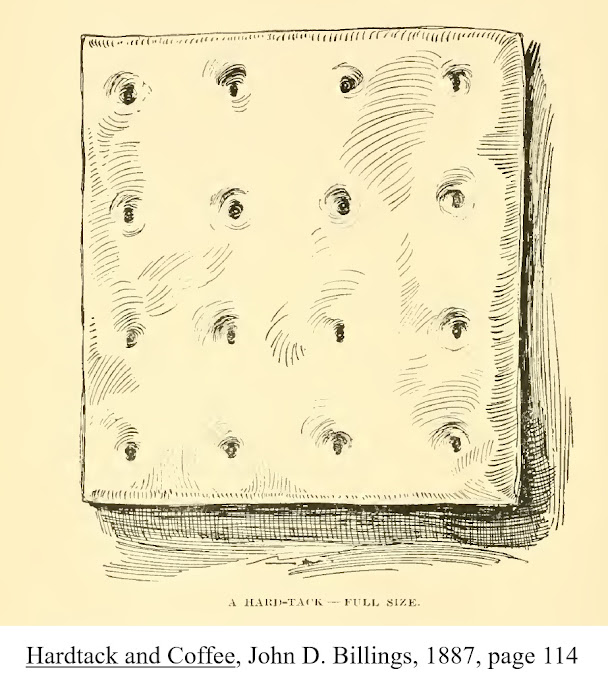Hardtack, no matter what you call it, “dhourra”, as ancient Egyptian mariners called it, “buccellum”, as the Roman legionnaires knew it, or later more descriptive names like “worm-castles”, “sheet-iron”, and “sea biscuit”, can be hard to eat.
The
first time I made hardtack, way back in the summer of 2007, I used all-purpose
white flour and rolled the dough out thin, just like the hardtack from the 19th
century and the American Civil War. These
hardtack biscuits were very difficult to eat.
The
hardtack that I am taste testing today was made back in December 2019 (for more
on making hardtack, read “Hardtack, The 18th and 19th Century Survival Ration
©”, HERE),
and at only four years old, is practically freshly made! This batch was made from wholewheat flour and
is thicker, in the manner of biscuits from the late 18th century,
and overall is a lot easier to eat than was the first batch.
Obviously,
just taking a big bite of hardtack won’t work, so how did late 18th
and 19th century soldiers eat hard tack? Well let’s try out some of the different
hardtack munching techniques and find out which one works best.
Smash it with the butt of your gun...
So, with just one whack of my trusty hatchet, the hardtack broke into pieces, perfect for taste testing! They were crunchy and I was able to easily crunch them with my molars. I thought that they tasted pretty good, since they were made with whole wheat flour, they tasted kind of nutty, and the broken up pieces could easily have been kept wrapped up in a square of cloth or in a pouch in a haversack and eaten as a snack on the march. My first hardtack batch, from 2007, wasn’t as easy to break up with a hatchet, or as easy to crush with my teeth.
Soak it in water or
coffee...
Toast it by a fire...
I broiled a hardtack biscuit for five minutes, and it became softer, and I was able to bite a big mouthful out of it, however, as soon as it began to cool, it became too hard to bite again. Unfortunately, I didn’t broil any of the all-purpose flour hardtack, and I didn’t want to sacrifice my last remaining biscuit today, so I don’t know if the all-purpose flour biscuits would have softened from being toasted.
But
why were my results different between the two batches and different from what
author Wilbur F. Hinman experienced during the American Civil War?
Apparently,
it has to do with the difference between whole wheat flour and all-purpose flour. Since the whole wheat flour is made from the
entire kernel of wheat, the bran, germ, and endosperm, and all-purpose flour is
made only with the endosperm, it changes the way that the gluten develops. Jorgen Calson, writing in “Baking Bread with
Whole Wheat Flour”1, noted “You see, when you are mixing your
dough and kneading or folding it you are aligning and strengthening the gluten
strands in the dough. These strands give the dough its strength and are what
allow the dough to trap the gas produced by the yeast which results in volume.
The bran flakes and germ in whole wheat flour act like tiny little razor blades
that shred these strands, inhibiting gluten development. The more whole wheat
flour you use the more bran and germ there is in the dough and the more the
gluten gets shredded”. And 100%
Whole Wheat Flour (13.5% Protein)”2 wrote that “Flours with
higher protein absorb more liquids than low protein flours”, which might
explain why my whole wheat batch became so much softer when soaked in water,
than did the all-purpose flour batch.
“...boil’em,
bake’em, float’em in a stew...no matter what you do, they’re still hard to
chew...”
Don’t forget to come back next week and read “The Survivors Dilemma
©”, where we will talk about what four things you would grab from a crashed and
sinking plane and why and what, you should grab.
I
hope that you continue to enjoy The Woodsman’s Journal Online and look for me
on YouTube at BandanaMan Productions for other related videos, HERE. Don’t forget to follow me on both The
Woodsman’s Journal Online, HERE,
and subscribe to BandanaMan Productions on YouTube. If you have questions, as always, feel free
to leave a comment on either site. I
announce new articles on Facebook at Eric Reynolds, on Instagram at
bandanamanaproductions, and on VK at Eric Reynolds, so watch for me.
That
is all for now, and as always, until next time, Happy Trails!
Notes
1
“Baking Bread with Whole Wheat Flour”, Jorgen Carlson, August 1, 2012 (HERE).
2 “100% Whole Wheat Flour (13.5% Protein)”, (HERE), which wrote that “Flours with
higher protein absorb more liquids than low protein flours”, which might
explain why my whole wheat batch became so much softer when soaked than did the
all-purpose flour batch.
Sources
Billings, John D.; Hardtack
and Coffee, [George M Smith & Co., Boston 1887], page 114 to 117, https://ia804500.us.archive.org/10/items/hardtackcoffee00bill/hardtackcoffee00bill.pdf,
accessed October 7, 2023
Hinman, Wilbur F.; Corporal
Si Klegg and His “Pard”, [The Williams Publishing Company, Cleveland OH,
1887], page 199 to 202, https://books.google.com/books?id=NrmYIZchZNwC&printsec=frontcover&dq=%22Corporal+Si+Klegg+and+His+%E2%80%9CPard%E2%80%9D&hl=en&newbks=1&newbks_redir=0&sa=X&ved=2ahUKEwiJkpTCl-SBAxWlK1kFHf09AUEQ6AF6BAgGEAI#v=onepage&q=%22Corporal%20Si%20Klegg%20and%20His%20%E2%80%9CPard%E2%80%9D&f=false, accessed October 7, 2023
Minsker, Justin; “Hardtack,
the Original MRE!”, May 22, 2020, https://www.thc.texas.gov/blog/hardtack-original-mre#:~:text=Later%20names%20were%20more%20descriptive,%2C%20pilot%20bread%2C%20and%20brewis.&text=No%20one%20knows%20when%20hardtack,years%2C%20possibly%20back%20to%20prehistory,
accessed October 7, 2023













No comments:
Post a Comment